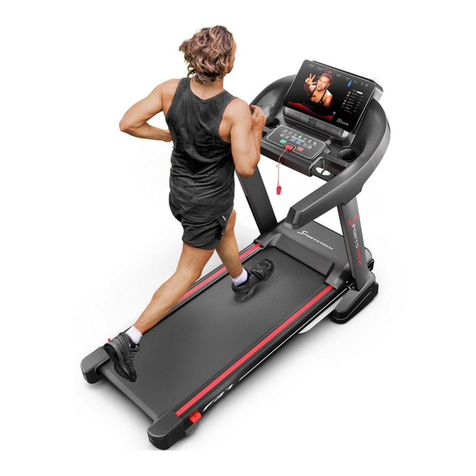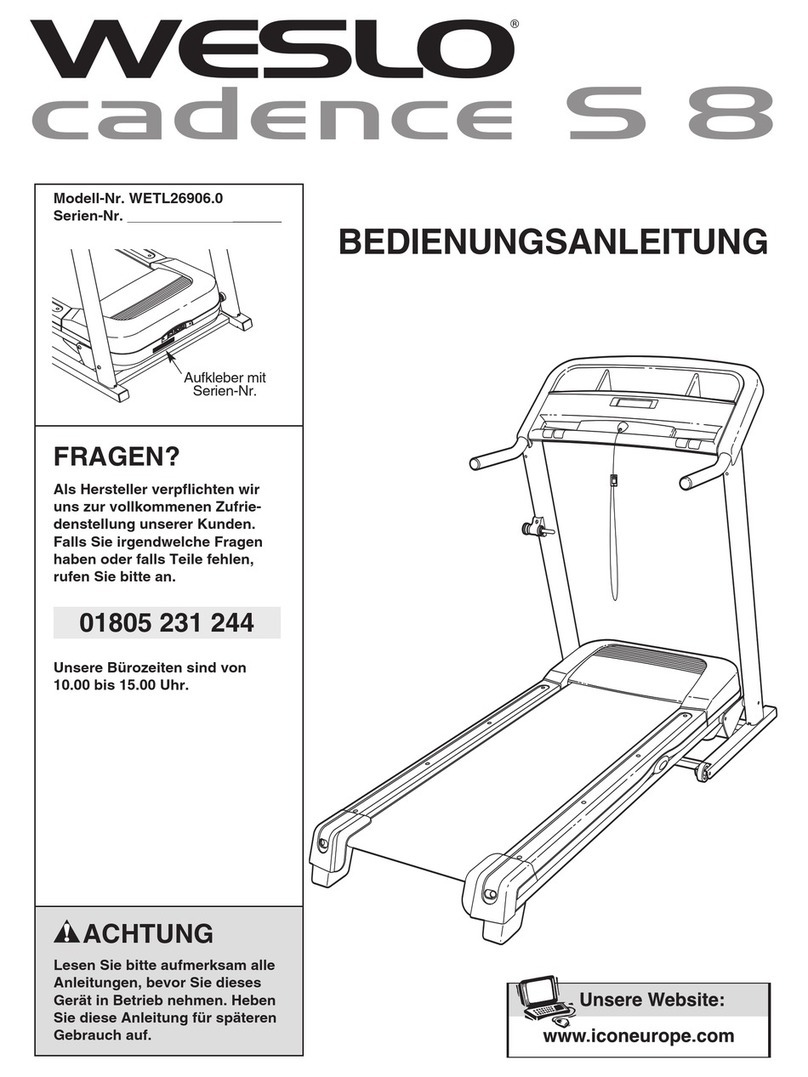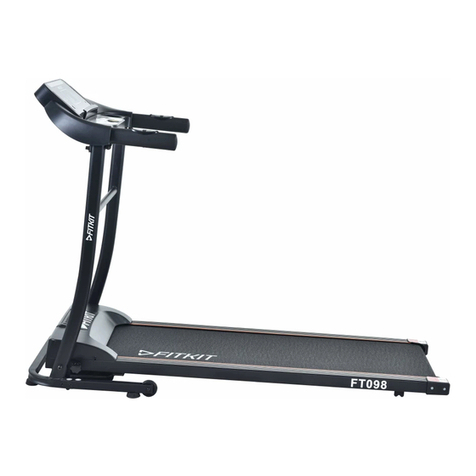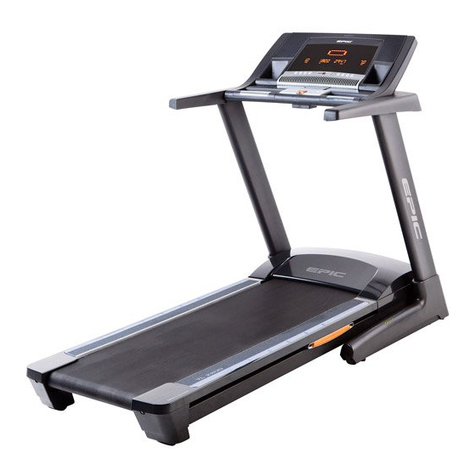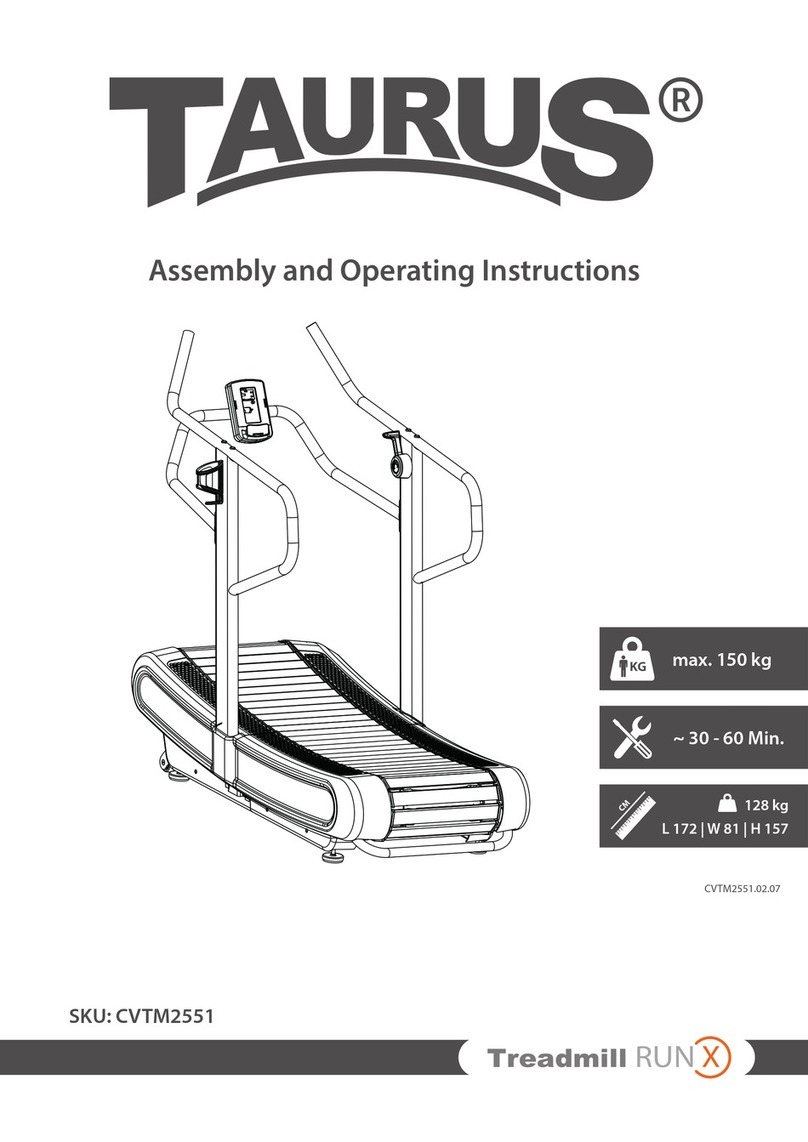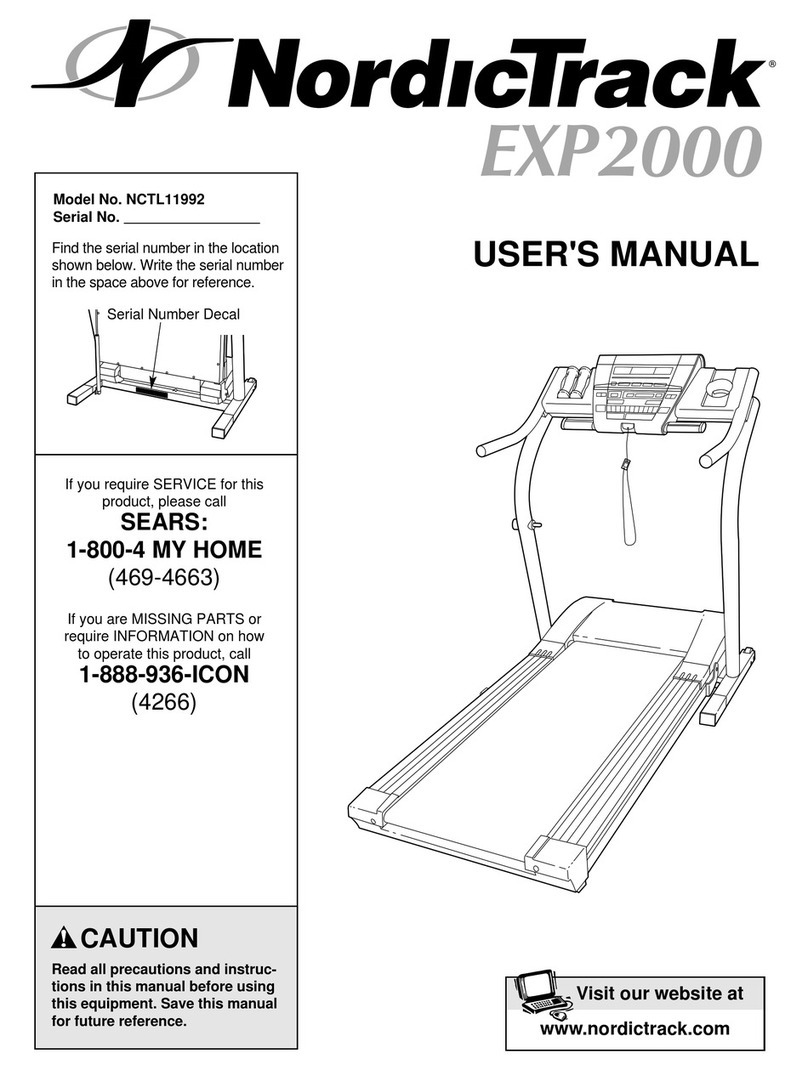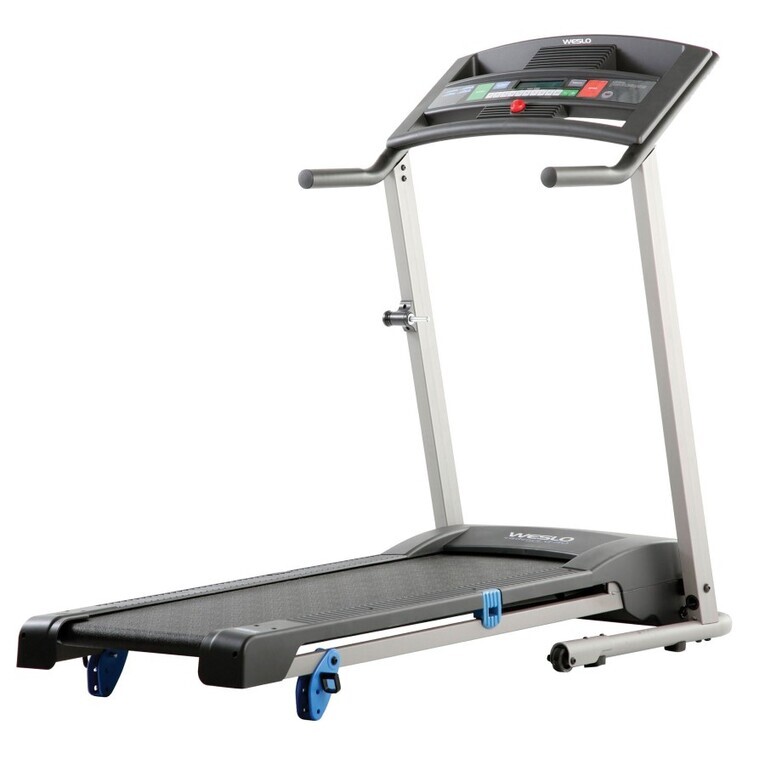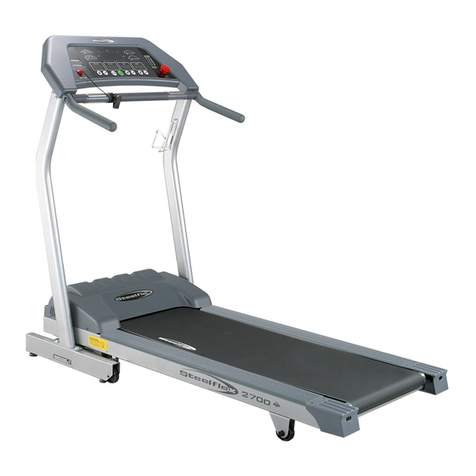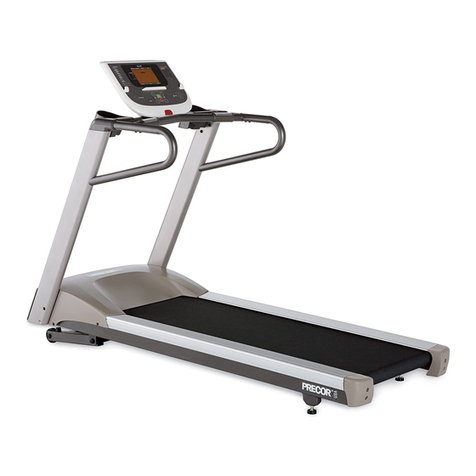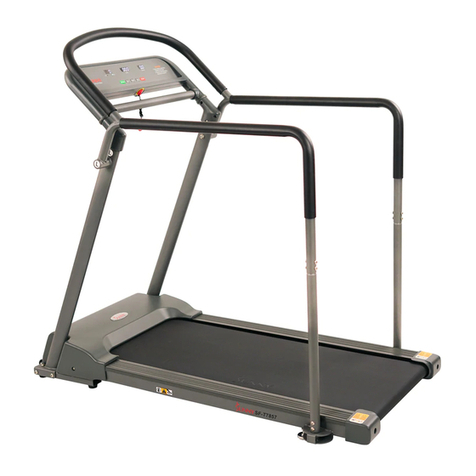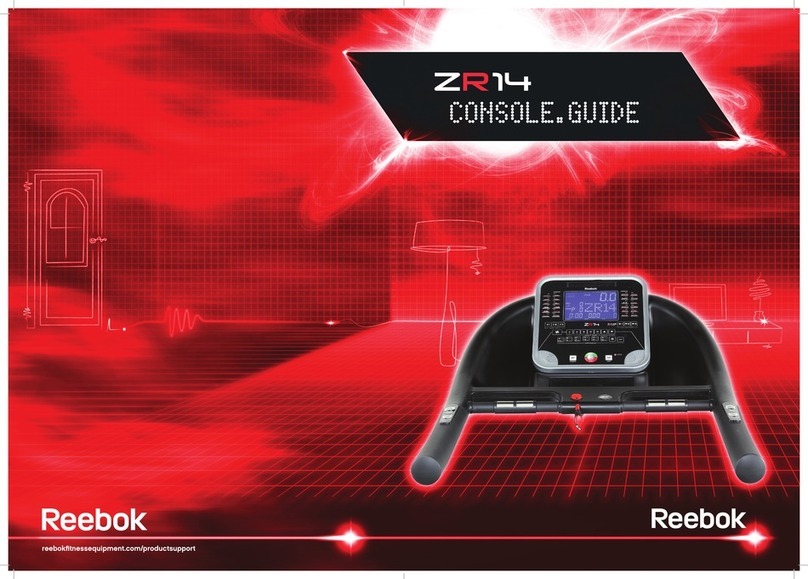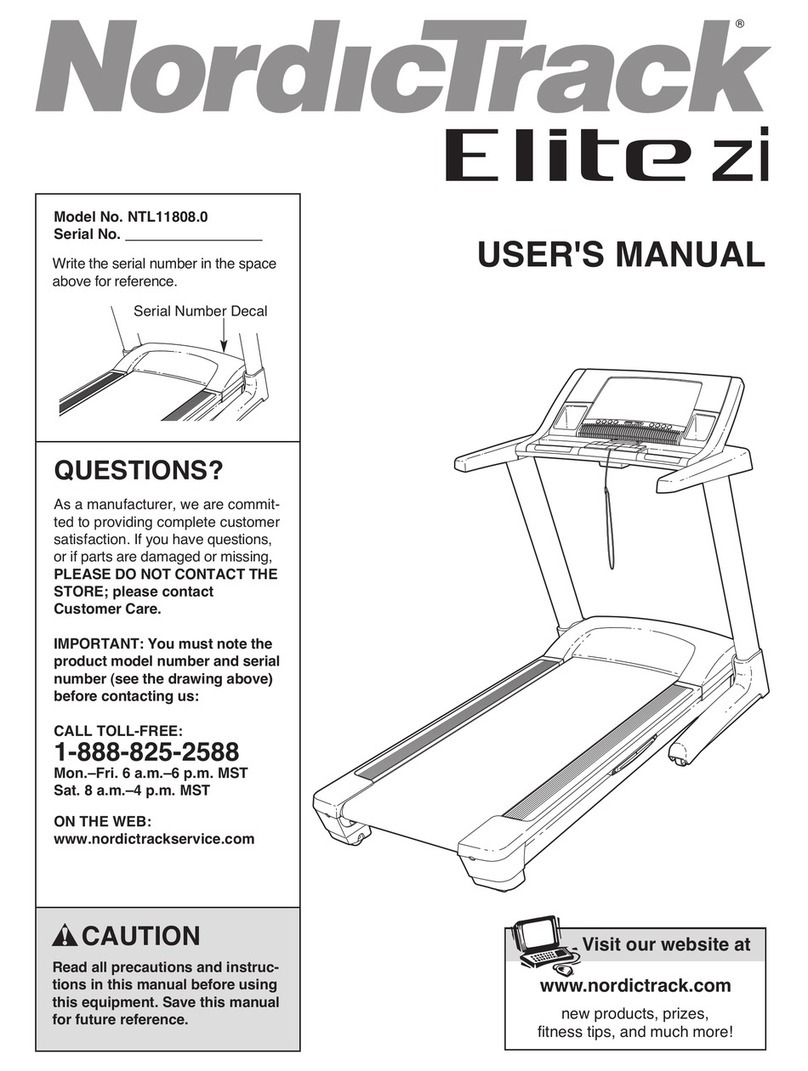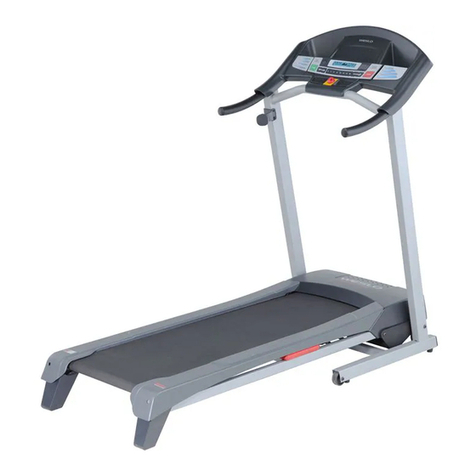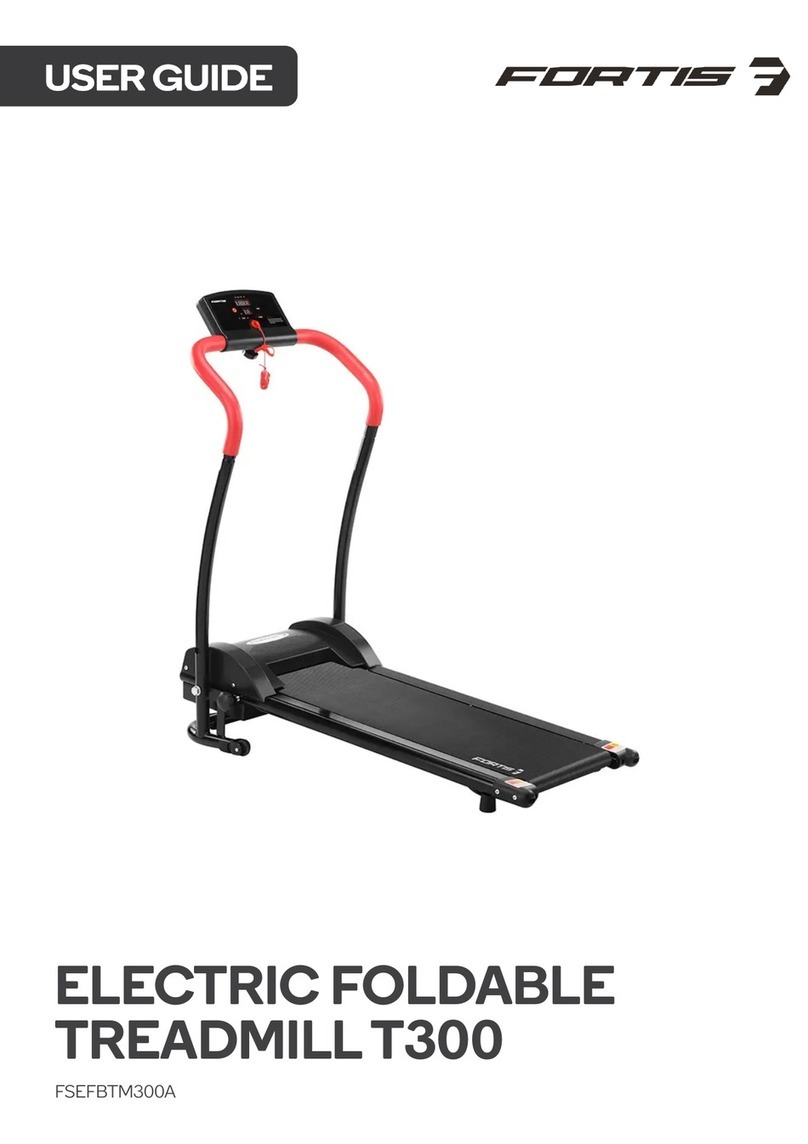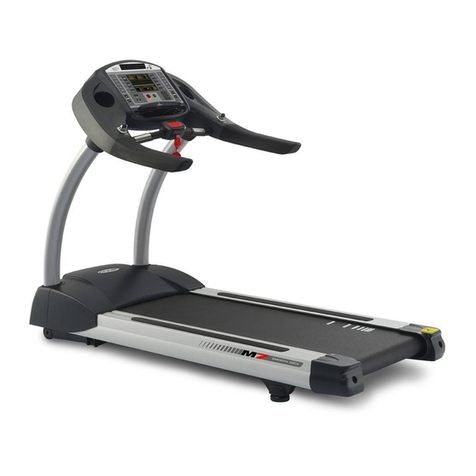Rogers TredSled User manual

0
s
ss
s
Product Information Packet
Product Information PacketProduct Information Packet
Product Information Packet
Product Name: Tred
Product Name: TredProduct Name: Tred
Product Name: TredSled
Sled Sled
Sled
Product Part Number: 410390
Product Part Number: 410390Product Part Number: 410390
Product Part Number: 410390

1
Table of Contents
Table of ContentsTable of Contents
Table of Contents
Introduction……………………………………………………………………………….……..……………….…
General Safety Rules…………………………………………………………………….…..……………….…..
Symbols……………………………………………………………………………………..…………………...…
Technical Specifications………………………………………………………………..………………………...
Setup Instructions………………………………………………………………………………………………..
Operating Instructions……………………………………………………………………………………………
Computer Instructions…………………………………………………………………………………………
Maintaining the TredSled…………………………………………………………………………..………..
Customer Service Information………………………………………………………..…………...…...……….
Introduction
IntroductionIntroduction
Introduction
The Rogers Athletic TredSled
tm
has been designed and manufactured with safety, performance and
dependability as top priorities, making it easy to operate and maintain.
The care you give your TredSled
tm
will greatly determine your satisfaction with its performance and service life.
Careful study of this manual is encouraged to obtain a thorough understanding of your new TredSled
tm
and its
functions.
If your manual is lost or destroyed, Rogers Athletic will gladly provide you with a new copy. Should you require
additional information or assistance, please feel free to contact us at 1-800-457-5337.
Note on power supplies: Power supplies in units that are sold in the United States utilize 120VAC, 60Hz, at 5
Watts Max and has an output of 9.0VDC at 300mA. Power supplies in units that are sold internationally utilize
90-264VAC, 47-63Hz, at 15 Watts Max and has an output of 9.0VDC at 1.66A
BECAUSE ROGERS ATHLETIC MAINTAINS AN ONGOING PROGRAM OF
PRODUCT DEVELOPMENT AND IMPROVEMENT, WE RESERVE THE RIGHT
TO MAKE IMPROVEMENTS IN DESIGN OR CHANGES IN SPECIFICATIONS
WITHOUT INCURRING ANY OBLIGATIONS TO INSTALL THEM ON UNITS
PREVIOUSLY SOLD.
1
2
3
4
7
8
9-10
11-13
14

2
General Safety ules
General Safety ulesGeneral Safety ules
General Safety ules
WARNING!
READ AND UNDERSTAND ALL INSTRUCTIONS.
Failure to follow all instructions listed below may result in serious personal
injury.
SAVE THESE INSTRUCTIONS
Obtain a medical exam prior to beginning any exercise program. Use equipment only if properly fit
to engage in physical activity.
Stop exercising if you feel faint, dizzy, or experience pain at any time while exercising and
consult your physician.
Set up TredSled on level surface.
Keep body and clothing free from and clear of all moving parts
Inspect equipment prior to use. DO NOT use if it appears damaged or inoperable.
Never operate with more than one person on the machine at a time.
Do not bring foreign objects onto Tred Sled™, they may fall and become jammed in unit.
Save these instructions. Refer to them frequently and use them to instruct others who may use the
TredSled™. If you loan someone your TredSled™, loan them these instructions also.
Read the Product Information Packet. Failure to read the information packet is considered a misuse
of this equipment.
Become familiar with all caution and warning decals affixed to the equipment before use.
Never cover or deface caution/warning labels.

3
Symbols
SymbolsSymbols
Symbols
Read the Operator’s Manual:
To reduce risk of injury,
user must read and understand operator’s manual before
using this product.
Safety Alert: Precautions that involve your safety.
Pinch Point Symbol:
Failure to keep hands away from
pinch points may result in personal injury.

4
Te
TeTe
Technical
chnicalchnical
chnical
Specifications
SpecificationsSpecifications
Specifications
TredSled
TredSledTredSled
TredSled (Part # 410390)
(Part # 410390) (Part # 410390)
(Part # 410390)
TredSled
tm
Construction, Finish, and Hardware
- Constructed of ASTM specified steel.
- Baked-on powder coat finish.
- Zinc-plated hardware.
Weight: 930lbs (422 kg)
Height: 70 in. with pad (178 cm)
Length: 8’ (244 cm)
Width: 5’ (152 cm)
- Athlete drives the non-motorized tread while its
braking system resists his/her movement.
- The brake can be set at different levels of
resistance for players/athletes of any position or
fitness level.
- Provides quantitative feedback to show
improvements in user’s performance.
- Has two modes block/tackle mode and sprint mode.
- Block/Tackle mode measures response
time, impact force and distance.
- Sprint mode tracks sprint distance.
- TredSled can be programmed for group workout
sessions. Enter the number of players (up to 6), the
duration and number of the workouts per player,
and the rest time. TredSled signals each Player to
get ready, begin, and stop, repeatedly throughout
the training session.
- With automated training sessions, many players
can complete their work-out in a short period of
time. - In Block/Tackle mode players can complete
a workout consisting of ten, four-second
work periods in one hour.
- In Sprint Mode, players can complete a
workout consisting of ten, four-second work
periods in one hour.
- TredSled includes the shock pad and sprint
harness.

5
Setup Instructions
1
2
Place pad over TredSled pad beam and insert pad pin at desired height in one inch increments.
Do not
operate without pad attached.
Unbolt computer pedestal from the shipping bracket that it is attached to (Shipping bracket is no longer
needed). Carefully position pedestal over the TredSled side tube and use the supplied bolts to secure the
pedestal to the tube. Make sure all wires are completely thru the top of the side tube before tightening bolts.
Avoid spilling liquids around computer bracket.

6
3
Adjust by tightening or loosening
feet with crescent wrench
Before using the TredSled, make sure to adjust the feet on the bottom part of the unit to ensure that it is
level (to adjust use crescent wrench). Lift pad and place over post. Set pad to preferred height and put
Faspin in to lock position. Make sure all four feet are in contact with the ground before use.
Lift pad and place
over post. Set pad to
preferred height and
put Faspin in to lock
position.

7
4
When using the TredSled there is an option to use the resistance belt for a different type of training. The
resistance belt is attached to the back of the pad and hooks to the users harness. When not using the
resistance belt be sure to remove from the TredSled.

8
Operating the TredSled
Operating the TredSledOperating the TredSled
Operating the TredSled
1. Before operating the TredSled make sure the machine is leveled and the computer pedestal is in place
(see steps 2 and 3).
2. Next the pad must be attached to the TredSled(see step 3)
3. After setting up the machine go to the front of the TredSled and open brake adjustment hatch. Inside
will be a knob that will adjust the brakes for the belt (giving more or less resistance). Adjust knob to
preferred resistance (see diagram below).
4. When using the TredSled there are two different ways to operate. You can face the pad and run against
it as if replicating blocking or you can use the resistance band to run away from pad. This builds power
and explosion.
5. The computer system on the TredSled is designed to keep track of players force, max impact, distance,
number of hits, and average force and power (see computer instructions for setup).
Belt resistance
adjustment knob
Shown without hatch door.
Blocking shown
on TredSled.
TredSled shown using resistance belt.

9
Computer
ComputerComputer
Computer Instructions
Instructions Instructions
Instructions
1. To power on the computer plug in the cord on the computer stand and flip the switch to the on position.
2. A short time after powering the computer on, press enter to begin training.
3. Next, the display will ask you how many players will be participating in the drills. Enter any number from
1-6 and press enter. At any time you can press the “back” key to return to the previous menu.
4. Press 1 to select Offensive drills, press 2 to select Defensive drills. Press enter to continue.
5. At this point four different modes will be displayed depending on whether you picked offensive drills or
defensive drills.
***Although relayed in Football Terms, simulated movements for other activities can be substituted***
a. Offensive Drills
1. Pass Protect – Simulates pass blocking.
i. Set Tension on belt as desired. Set high enough to hold belt still.
ii. Get in stance and wait for signal.
iii. Explode into pad with hands keeping separation.
iv. Continue hitting pad repeatedly, or as desired.
v. Change Players
2. Sprint – Simulates open field running.
i. Remove all tension from belt.
ii. Attach Harness to back of pad.
iii. Wrap Harness around player, with player facing away from pad.
iv. At signal sprint away from pad.
v. At signal stop/switch player
3. Drive Block – Simulates open field blocking.
i. Set Tension on Belt as desired, allowing movement.
ii. Get in stance and wait for signal.
iii. At signal explode into pad at desired height and form as to block.
iv. Drive legs on belt until stop signal.
v. Switch Player
4. Zone Block – Simulates open field blocking.
i. Set Tension on Belt as desired, allowing movement.
ii. Get in stance and wait for signal.
iii. At signal explode into pad at desired height and form as to zone block.
iv. Drive legs on belt until stop signal.
v. Switch Player
b. Defensive Drills
1. Bull Rush – Simulates QB rush.
i. Set Tension on Belt as desired, allowing movement.
ii. Get in stance and wait for signal.
iii. At signal explode into pad at desired height and form as to pass rush.
iv. Drive legs on belt until stop signal.
v. Switch Player
2. Sprint – Simulates open field running.
i. Remove all tension from belt.
ii. Attach Harness to back of pad.
iii. Wrap Harness around player, with player facing away from pad.
iv. At signal sprint away from pad.
v. At signal stop/switch player

10
3. Tackle – Simulates tackling.
i. Set Tension on Belt as desired, allowing movement.
ii. Get in stance and wait for signal.
iii. At signal explode into pad at desired height and form as to pass rush.
iv. Drive legs on belt until stop signal.
v. Switch Player
4. Hit and Read – Simulates in-game awareness.
i. Set Tension on belt as desired. Usually high enough to hold belt
still.
ii. Get in stance and wait for signal.
iii. At signal explode into pad at desired height and form as to zone block.
iv. Drive legs on belt until stop signal.
v. Switch Player
6. After picking a drill, the next step is to set the number of repetitions per user.
7. Next, set the amount of time of each repetition.
8. Then, set the amount of recovery time between each repetition.
9. Finally, set whether each repetition will have a silent snap, which is a light flashing on the display, or an
audible snap which is a beep from the computer.
10. First athlete gets ready for drill. Athlete will get a “warning” beep to be a ready. Then there will be a
start signal. (Either visual or audible). The athlete performs the rep, and then will get a finish signal.
The first athlete then exits the Tred Sled, and the next athlete get ready.
11. After all of the repetitions are done for all of the players the machine will display the results of the
workout. The display will show the following:
1. Pass Protect 1. Bull Rush
a. Response a. Response Time
b. Max Impact b. Max Power
c. Average Impact c. Average Power
d. Number of Impacts d. Distance
2. Sprint 2. Sprint
a. Distance a. Distance
3. Drive Block 3. Tackle
a. Response time a. Response Time
b. Max Power b. Max Power
c. Average Power c. Average Power
d. Distance d. Distance
4. Zone Block 4. Hit and Read
a. Response Time a. Response
b. Max Force b. Max Force
c. Average Force c. Average Force
d. Minimum Force d. Minimum Force

11
Maintenance
MaintenanceMaintenance
Maintenance
WARNING!
READ AND UNDERSTAND ALL MAINTENANCE PROCEDURES.
Failure to follow all procedures listed below may cause serious injury and/or
decrease equipment functionality.
Frequently check to see that all bolts are securely fastened.
Touch up paint may be used to cover scratches or blemishes sustained through use.
Frequently check to see that weight equipment is functioning properly.
A silicone based lubricant may be used on moving parts to maintain proper function.
Mild detergent or disinfectant may be used to clean weight equipment.
Soapy water may be used to clean the tread.
Replace any damaged equipment with genuine Rogers Athletic parts. Failure to do so may result
in unsafe equipment and/or personal injury.

12
Maintaining the TredSled
Maintaining the TredSledMaintaining the TredSled
Maintaining the TredSled
Belt Tension Adjustment
After repeated use it may be necessary to increase the tension in the TredSled belt for optimal performance. In
order to adjust the belt tension the side plates must be removed. Use a 5/32” Allen Wrench to remove the bolts
that hold the side plates on. Set side plates and bolts aside. (See figure 1) At the back end of the TredSled
there are two bearing block brackets that must be loosened before belt tension adjustment can be done. Use a
9/16” End Wrench to loosen the four bolts that are used to mount the bearing block. Loosen the bolts by
turning the lock nuts counter clockwise until the bearing block is free to move. This step must be completed
on both sides of the TredSled for tension adjustment to be possible. (See figure 2) With bearing blocks
loose on both sides of TredSled use a 9/16” deep socket to adjust belt tension. Insert socket into the top hole
of the back bumpers and turn bolt heads clockwise to increase the belt tension and counter clockwise to
decrease the belt tension. Make sure to turn both bolts in equal amounts to allow belt to track properly when in
use. Once the desired tension has been reached be sure to tighten down all the bolts on the bearing blocks to
secure their positioning and belt tension. With bearing blocks tightened down reattach the side plates and
tighten down all bolts to complete the belt tensioning adjustments. (See figure 3) These adjustments will make it
possible to tighten belt if it appears to be loose or hanging. To adjust the belt from side to side follow step one
by removing the side panel and loosening the four bearing block nuts. Then go to the back of the machine and
depending on which way the belt is offset, insert socket into the top hole of the back bumper and tighten the
tension screw one full rotation (For example, if the belt is riding to the left side you will go to the left side and
tighten the tension screw one complete rotation). After adjusting, before replacing the side panels, you must run
on the TredSled to allow it to balance itself out(To ensure that the belt is sitting properly run the belt both
forward and backward. If belt is still not sitting centered you may have to take some of the adjustment off and/or
add more. Repeat until centered). Replace all side panels after adjusting.
Figure 1
Adjusting the tension will
move the rollers farther
apart or closer together.

13
Figure 2
Figure 3
A
4 Bearing Block Nuts
Tension
Screw
Back Bumper

14
Adjusting the Brake
Adjusting the BrakeAdjusting the Brake
Adjusting the Brake
If you are experiencing problems with the TredSled’s brake system (not being able to tighten or loosen the
brake to allow free running or a standing belt), follow these instructions.
1) Check gap between roller and side frame.
a) The inner and outer positioning spacers should hold the roller in place during shipping and
installation, but sometimes when the machine is being transported through doorways it is put on its side
which in turn puts a large amount of force on the roller (models made before January 2012 do not have
positioning spacers). If the roller is centered, skip to step 2 (see Section B). If not continue to part b.
b) If the roller has moved, the brake rotor can rub on the brake caliper causing the brake to not function
properly. If the roller is not centered you must take the cover off the opposite side. Here you will see the
bearing that holds the roller. On the bearing there is an adjustment screw. Loosen up the screw until
you can slide the roller. From here you will adjust the roller so there is approximately ¼ inch on both
sides between the roller and the side frames. After moving the roller you must then re-tighten the
adjustment screw.
2) Check caliper for binding.
a) The brake caliper lever arm should be bolted on so that the two allen bolts are at the top and bottom
holes with the lever arm pointing straight down (see Detail A). When the lever arm is pointing straight
down the brake is at minimum resistance. The brake caliper should float in the mounting bracket when
at minimum resistance (there should be a slight side to side movement). If there is slight movement,
skip to step 3. If there isn’t movement continue to part b.
b) If there is no free movement, please verify that the outer brake pad (movable) is not against the
brake rotor by pressing on the outer face of the brake caliper lever arm. There is a light spring behind
the lever arm assembly and you should be able to compress it slightly if the brake pad is not against the
rotor. If you cannot compress the spring slightly then the outer pad is against the rotor and you must try
to reduce the brake sensitivity. Remove the cotter pin from the brake caliper assembly and rotate the
castle nut one turn counter clockwise to loosen it. Recheck to see if the caliper assembly is now
floating. This can be repeated again but you must keep track of how many turns it has been adjusted
so you can return it later. If one turn or less corrects the problem reinstall the cotter pin and verify both
minimum and maximum brake resistance settings. If there is still no brake caliper movement and the
lever arm can be compressed slightly then the brake caliper may be rubbing against the back (fixed)
brake pad. To correct this proceed to step 3.
3) Correct position of Brake Rotor
Before beginning this step make sure roller is not contacting either of the side frames.
a) IMPORTANT: Using a sharpie marker make a line around the shaft at the face or inside the
bore of the taper lock bushing to provide a reference mark.
Locate the three bolts that retain the brake rotor taper lock bushing and remove them (see Detail A).
Now take three 1/4in-20 bolts into the threaded holes adjacent to the original bolt positions and tighten
them slightly until you feel the taper lock bushing release. If you use the same bolts that you removed
from the taper lock be sure to not crank on them to the point that they mushroom or strip the threads.
Move the brake rotor assembly towards you 1/8 inch (this will just about cover the reference mark if it
was made with a new “sharp” marker). Recheck for movement in the caliper assembly, it should now be
loose. If it is still not loose then move the rotor another 1/8 inch towards the outside of the machine.
Recheck for movement in the caliper assembly, it should now be loose. Remove the bolts from the taper
lock bushing and thread them into the original mounting holes. Lightly and evenly tighten the bolts until
they are all against the front surface and then start using a pattern moving from one bolt to the next as
you evenly tighten the taper lock bushing. This is important because you need to keep the brake rotor
running true so the brake system doesn’t pulsate when applied. The brake rotor will move outward
slightly as it is tightened so you may possibly need to repeat this process if it was moved too far the first
time. Recheck for movement in the caliper assembly, it should still be loose.

15
BRAKE CALIPER LEVER ARM
BOLTS AT TOP AND BOTTOM
THREADED REMOVAL
BOLT HOLES
BRAKE ROTOR TAPER
LOCK MOUNTING BOLTS

16
CHECK GAP BETWEEN
ROLLER AND WALL (9/32 in.)
BRAKE CALIPER
MOUNTING BRACKET
SECTION B
SCALE 1/10
INNER POS
I
TIONING SPACER
BRAKE ROTOR
OUTER POSITIONING SPACER
SPACERS PREVENT FRONT ROLLER SIDE
MOVEMENT DURING SHIPPING AND INSTALLING
BRAKE ROTOR TAPER LOCK
BRAKE CALIPER ASSEMBLY
SHOULD FLOAT IN MOUNTING BRACKET
WHEN AT MINIMUM RESISTANCE
CHECK FOR SIDE TO SIDE MOVEMENT TO
AVOID RUBBING AGAINST ROTOR
CALIPER RETURN SPRING

17
Customer Service
Customer ServiceCustomer Service
Customer Service
For parts or service contact Rogers Athletic Company. When ordering parts be sure to provide all relevant
information available including the name and part number of the equipment purchased. This information is
located on the cover of this product information packet. Hours of phone service are Monday through Friday from
8:00 a.m. to 5:00 p.m. Eastern Standard Time. Customers can phone (989) 386-2950 or toll free at (800) 457-
5337. Fax toll free at (888) 549-9659 or mail to:
Rogers Athletic Company
3760 W. Ludington Drive
Farwell, MI 48622
Rogers Athletic Company
3760 N. Ludington Drive
Farwell, MI 48622
www.rogersathletic.com
(989) 386-2950
(800) 457-5337
Fax toll free (888) 549-9659
PIP410390
This manual suits for next models
1
